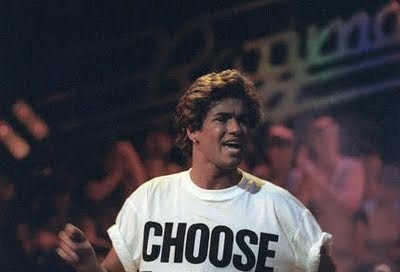Trainspotting: The One Where We Dive Into the Worst Toilet in Scotland (Literally)
Dissecting the cult chaos of Danny Boyle’s most unforgettable trip.
THANKS TO ALL OF YOU WE GOT OUR 1st 100 SUBSCRIBERS! We will start a regular schedule with the posts but wanted to kick off this 1st week with a bang.
In this week’s episode of Unspooled, we tackled Danny Boyle’s 1996 adrenaline shot of a film, Trainspotting—a movie that somehow makes heroin addiction, nihilism, and a toilet crawl into an anthem of a generation. But as always, we’ve got more to say than what fits in the pod.
Here are your bonus bits— and, yes, how they created the most revolting toilet in cinema history.
“Choose Life.” But Also, Choose Wham!
Renton’s opening monologue came from fashion and pop music. The “Choose Life” slogan originated in the early 1980s as part of a campaign by designer Katharine Hamnett, promoting anti-war and anti-drug messaging.
George Michael even wore it in the Wham! video for Wake Me Up Before You Go-Go
What Does Trainspotting Actually Mean?
The title Trainspotting has layers. Here are the main interpretations people debate:
Literal Meaning: In British slang, “trainspotting” is a hobby where people observe and catalog trains. It’s obsessive, meticulous, and pointless to outsiders—which mirrors the characters’ drug habits. They chase the next hit like trainspotters chase engine numbers.
Junkie Parallel: As Irvine Welsh (the author) explained, heroin users can become hyper-focused on tiny details and repetitive routines—like trainspotters. It’s a lifestyle of narrowed vision and compulsive behavior.
Plot Connection: In the book, Renton and Begbie meet an old drunk man (possibly Renton’s father) in an abandoned train station who asks them if they’re “trainspotting.” The scene didn’t make the film, but it’s a thematic wink at generational cycles and wasted lives.
Existential Joke: Some critics believe the title mocks the search for meaning in meaningless activities. If you’re looking for purpose in Trainspotting, that might be the point—it’s about a generation going nowhere, fast.
WAS BEGBIE CLOSETED?
On a BAFTA website, Carlyle says that he became convinced that Begbie was in the closet after he read a scene in which he has a run-in with a trans woman.
“He picks up the transsexual in the nightclub and there’s the scene in the car where he puts his hands between the trousers and finds out it’s the real deal. Now why doesn’t he just kill this person? He kills everybody else, why doesn’t he do that? He gets frightened of it and backs away. Back at the flat, Begbie reacts to Renton winding him up about it and says, ‘Don’t you ever mention that again or you’re dead.’ I thought, ‘That’s interesting, that’s really too strong.’”
The author of the novel, Irvine Welsh has also agreed with Carlyle’s interpretation and suggests that though he intended for Begbie’s sexuality to be ambiguous in the book, he was most probably played as gay on screen. “I think the Begbie of the film is more potentially gay than the Begbie of the book,” said Mr Welsh.
Danny Boyle on the “Worst Toilet in Scotland”
Director Danny Boyle knew this scene was disgusting, but it had to be theatrically disgusting. He called it a “hallucinogenic sequence” and filmed it like a dream. But how did he do it.
EASIER TO QUIT THAN HEROINE
Here’s a few deleted scenes left of the cutting room floor that all add a bit more flavor to the film.
I think this might be my favorite.
ICYMI: The Episode
Listen to Trainspotting on Unspooled [Subscribe to Unspooled wherever you get your podcasts]
Till next week







